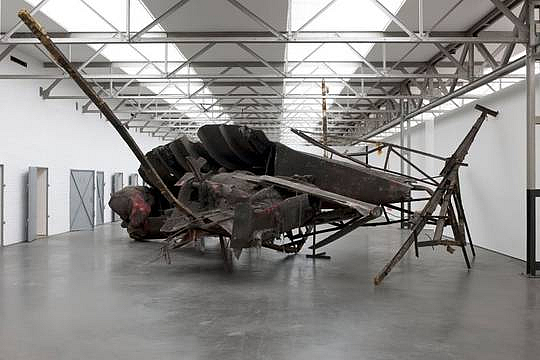Peter Buggenhout
Invertebrate
28 May -18 Sept 2011
Just as in 2004 and 2008, De Pont is holding a presentation within the context of Lustwarande '11. This international sculpture exhibition will take place for the fourth time this summer in Tilburg's park DeOude Warande. Its overall theme this year is the concept 'Raw'.
The sculptures of Peter Buggenhout (Dendermonde, 1963) are certainly raw and unpolished. At the same time they have a vulnerable and transitory appearance. The works have been made with 'vile' materials, things that no have a function or meaning and which people prefer to be rid of: construction material, packaging material, discarded molds, sheets of plastic, frayed cloth but also horsehair, blood, cow stomachs and household dust.
In the brick corridor at De Pont, a few of Buggenhout's sculptures have been placed on glass tables that have rigid metal supports. The intensity of the works contrasts with the coolness of the presentation. On display in the main exhibition space is an awe-inspiring constellation of shredded and now unrecognizable materials, hidden beneath a thick layer of household dust. Taking a distance from this is impossible. The installation unfolds in many perspectivesand details, but a grasp of the form eludes us.
Rather than deliberate and planned interventions, it is the dynamics of growth and decay, of construction and destruction that gives reality its ever-unfinished and inexplicable form. Buggenhout has made that factor the formative principle of his art. His sculptures look as though they have not been made, but have taken shape under the influence of conflicting forces. He himself compares this generative process in his sculptures to the way in which a fungus spreads, taking possession of it's surroundings and eating into this as it continues to spread. The artwork is finished when the various materials have found a tight balance with each other.
Aside from the form, the nature of the surface also contributes significantly to the specific character of his sculptures. In the 'dust sculptures' forms are covered with a thick layer of dust. Light skims across the soft matte texture and reveals the undulations of an uneven surface. Oddly enough, the weave of grey fluff and threads,places the sculptures at a crossroads in time. Concealed beneath the settled dust are forms that tell of a turbulent past. At the same time, the fragile formations of dust emphasize the fleeting quality of the moment and already hold the beginnings of a subsequent metamorphosis.
Peter Buggenhout began his artistic life as a painter. His concern for the texture of his sculptures show that he has remained one in a certain sense. His decision, ten years ago, to stop painting and focus on sculpture was based on his desire to liberate himself from any form of representation. Hissculpture aims to represent nothing other than itself. The works depict nothing. They are something: fragments of matter, formed throughout open-ended processes. Buggenhout confronts the viewer with a raw reality, one that evokes both repulsion and fascination.
